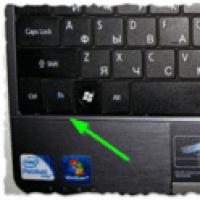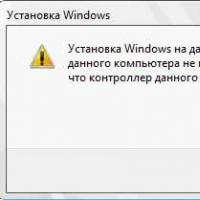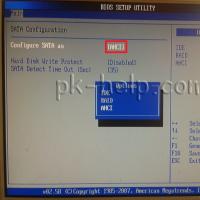The screen does not see modes with 75 hertz. Overclocking of the matrix of the monitor - theory and practice. Requirements for computer
About the fact that you can dispersed the processor, a video card or RAM, I heard, I think most PC users. However, the monitor can also be dispersed, know a few, and often the difference from its acceleration is more significant and more noticeable than from overclocking the other iron. She is also safer, but about it below.
Theory
To begin with - what is meant by acceleration of the monitor matrix? It is understood as an increase in the frequency of updating the monitor with the standard 60 Hz and how much it turns out - 70-75, it also happens 120, and even 150 Hz (!). Why do you need it? To increase smooth pictures. What does the monitor update frequency mean - 60 Hz? This means that the picture on the screen is changing exactly 60 times per second. In this case, the video card can produce both fewer FPS and more. If the number of frames issued by the video card is less than the update frequency, then, it means that some frame will be twice (and then three times) is displayed on the screen, which can lead to tangible delays. If the number of frames issued by the video card, more frequency of the monitor update, will turn out that two or three frames will be released on the screen, which will lead to artifacts:

Compromise is the installation of vertical synchronization. What is her essence? It rigidly binds one frame prepared by the video card, to one update of the picture on the monitor. And here, if your video card gives steadily more frames than the monitor update frequency, then you will get an ideal smooth picture, well, and your video card will not be loaded at 100% at times and will rest. And it is precisely such a mode of operation that is often used in the system - for example, when you scroll in the browser, you do not see artifacts, and at the same time scrolling smooth.
The raising frequency of the monitor update kills two hares at once: first, now vertical synchronization will go at a higher frequency, which means smoothness will still increase (I think everyone saw the difference in the rollers on YouTube with 30 and 60 frames? That's here too). Secondly, if your video card in the games gave up more than 60 frames per second, now the artifact appearance threshold is moved to a new update frequency, and the information on the screen will be updated more often, which is quite important for dynamic games.
Of course, the question arises - how safe is it? Much safer the overclocking of iron: if the monitor can not work at a given frequency, it will simply not turn on. If he earned at a given frequency - it means that you will not have any problems. Overheating to him, as in the case of acceleration of the processor or video card, does not exactly threaten.
Practice
Now, when a little figured out with the theory, you can go to practice. The first thing you need to know is any monitor and even laptop matrices, but there are several restraining factors at once. The first is a connection method: Through DVI, with a resolution of 1920x1080, you are unlikely to get over 65 Hz - a sufficiently low interface bandwidth affects. Through the old HDMI (up to 1.4), with the same resolution, you will most likely be able to get a frequency of about 75-85 Hz. Well, through new HDMI (1.4-2.0), Thunderbolt or DisplayPort restrictions are practically no - it is possible to obtain 120-165 Hz. Similarly, there is often no restriction in the matrices of laptops connected directly to the board. The second restraining factor is the matrix itself, or rather its controller. It happens that even with a rapid connection with increasing frequency, some artifacts of the image appear - alas, there will be no longer anything, except to reduce the frequency to the last stable.
Now let's talk about how to overclock. NVIDIA video card holders are lucky here - for them the algorithm is simple: you need to go to the NVIDIA control panel, go to the "Changing Resolution" tab, click on the "Setup" button, in the window that opens, put a tank on the on-making mode that is not supported by the display, then click On the "Create Own Resolution" button, and in the window that opens, we finally get access to the change in the update frequency:
The frequency is to lift at 3-5 Hz, and then click on the "Test" button. If no artifact appears and the image is - raise the frequency even higher. As soon as the artifacts appeared or the image was disappeared - reduce to the previous operating frequency, and then raise 1 Hz already - in general, everything is smoothly here as with the usual acceleration of the video card. After you have found the desired update frequency, simply save the resulting configuration, and it will appear in user permissions.
As you can see, there is no risk - if the monitor "did not start" in the frequency you specified, after 20 seconds the system will roll back the value of the frequency to the default. Alas - everything is so good only with NVIDIA video cards, with video cards from AMD or Intel worse - there is no frequency in the driver settings, but there is a universal application that will help it - it is called it Custom Resolution Utility (CRU), download it last Version can be.
Immediately warning - the program problem is that it does not have a test button, as in the case of NVIDIA, so frequencies are applied immediately and irrevocably. So if after setting the frequency you see the black screen - you will help or connect the second monitor and return settings to the default, or the occasion through the safe mode and the detection of the same.
It is easy to work with the program - you run it, delete all the permissions from the standard and remove all the checkboxes on the left (I will not do this, because it has already dispersed the matrix through the NVIDIA settings):
Now under the window with Detailed Resolutions click on the Add button, set Automatic - LCD Reduced and change the frequency of the update:
Here the principle is the same - we increase the frequency of 3-5 Hz, press OK, we keep and reboot everything. Now go to the AMD panel (or Intel) and exhibit a new frequency: 
Here, in general, everything - as you can see, nothing hard or dangerous.
Well, the last question remains - almost all the matrices accelerate, then why do not make manufacturers from the factory? Everything is simple: there is such a concept as standard, and for the frequency of monitors, it has already long been to 60 Hz. Therefore, manufacturers, even if the matrix is \u200b\u200bcapable of working at 70-80 Hz, still limit its frequency on the standard 60 Hz. Secondly, everything is often resting in a connection method. For example, it is possible to transfer 1080r60 by any interface, at least DVI, even thunderbolt 3. But for 1080r80, a special cable is already needed - DVI and old HDMI are no longer suitable. And in order not to create confusion, the manufacturers again limited to 60 hertz.
As for the question, overclock or not to overclock - to solve you and only you. If you have turned out to increase the frequency from 60 to 65 Hz - then there is no point in such an overclocking, you will not see the difference. But when overclocking, up to 75 and above Hz, the difference becomes clearly visible, so the game is worth the candle here. It should also be borne in mind that after overclocking, the load on the video card at normal work will increase - after all, it will now have to give more frames per second, so if you accelerate the matrix on a laptop - it should be borne in mind that you have a slightly will decrease the battery life.
Modern monitors have a considerable amount of characteristics and parameters, thanks to which we tend the choice of a specific model. Screen diagonal, matrix type, brightness, contrast, response. But there is a parameter that instantly hangs the "game" label to any monitor - this screen update frequency.Screen update frequency - characteristic, meaning the maximum number of frames per second, which can show the monitor (measured in Hertz (Hz)). Due to the high screen frequency, good smoothness is achieved, the dynamism of the image is achieved.
60 (75), 144 and 240 hertz
Most common monitors with a frequency of 60 Hz - These are the usual monitors that we used to see, the standard "today's" day. Films, Internet, work and study, games - fit for different tasks at an affordable price. There is an increased frequency of 75 Hz - to work and play such a monitor already more often. Many will convince you that there is no difference between 60 Hz and 75 Hz. Know - it is, it is worth only to try.
The standard "tomorrow" day is monitors 144 Hz. As a rule, such monitors can be considered gaming in absentia, and this is not enough, because the frequency is higher than almost 2.5 times. Such monitors are references in the cybersport industry, and not in vain have aggressive promotion and respect among young people, despite the high cost of 2-3 times. Even with web surfing, you will feel the smoothness of moving windows, cursor, content on the Internet, not to mention the game. These feelings are difficult to describe - it's better to try it once to understand, and be sure - one time will be enough to become far from the last.
Monitors 240 Hz- This is the "day after tomorrow" day, which will come not soon. Such monitors are flagships, and not every buyer can afford that pleasure. The difference in price is almost twice as much more than monitors 144 Hz, but the smoothness of the picture is no longer so much different than the monitors of 60 Hz and 144 Hz, although some changes are still noticeable. Due to the high price (2 times more than 144 Hz monitors) the demand for such monitors is not high, but we believe that one day these monitors will be in demand in the market.
Freesync (Freesync 2 HDR), G-Sync
The essence of Freesync (Freesync 2 HDR) and G-Sync is to force the monitor screen at the time of drawing the frame, synchronize the video card and monitor. After all, your cannot produce the same number of frames per second throughout the game, because of this, the visual breaks of the frame on the monitor arise.
Freesync belongs to AMD and controls the display frequency through the DisplayPort interface, while the G-Sync from NVIDIA uses its own development, a special chip installed in the monitor. Due to this, G-Sync will cost more, but any NVIDIA GTX level video card will calmly maintain this technology, while Freesync supports far from every AMD Radeon video card. Plus AMD Freesync is that it allows you to operate in the range of 9-240 Hz, while NVIDIA G-SYNC is only 30-144 Hz. To the same, NVIDIA proposes to disconnect the G-SYNC at all when dropping below 30 frames per second.

Requirements for computer
There is one substantial remark - once the monitor is capable of working at a frequency of 144 Hz, then it must produce at least 144 FPS (FRAME PER SECOND ( english.) - Frame per second). It will only be better, if higher, in the FPS game, the number of frames do not fall below 144, because It is fraught with a decrease in smoothness of the picture. Simple words - if the game on the computer gives only 60 frames, there is almost no meaning of 144 Hz or 240 Hz with a gaming monitor. About the power of your PC must be taken in advance - buy, and if necessary, refresh and, because They directly depend on the number of FPS.
- Dota II, CS Go, Overwatch will completely come down either, level processor and (or two strips of software) RAM to ensure stable 140-150 FPS
- GTA V, The Witcher III, Pubg (Playerunknown "S Battlegrounds) for 144 FPS will require a minimum one, and better two, level processor / either and (or two strips of software) RAM
However, FPS in games can be enhanced not only at the expense of powerful, as well as by lowering graphic settings in the game, as professional gamers and cybersports make it to achieve the maximum value of the FPS.

The best game monitors 144 Hz for their price
From the available options it is worth noting the monitor is a final version of the first - aesthetic design, a control panel, improved ergonomics and new software and hardware revisions reborn the iconic monitor. Well, finally, 34 "Inch monster - a curved IPS-matrix with a resolution of 2560x1080, Freesync support and much more will have to taste the most sophisticated gamer with a wide pocket, because At the cost of the monitor, more than $ 600 it is justified by 100%.
Any PC and Laptop owner have heard of the possibility of overclocking the processor and other components, but a few people know how to disperse a monitor. What is it for? To increase the smoothness of the picture and the speed of refreamed frames on the screen, as well as enhance FPS in games. Also, this option will be useful if your eyes hurt from work at a computer. Today we will tell how to overclock your monitor from 60 to 75 or 120 Hz.
What is improving?
The main parameter is to change the framework of refreshments (Hz). For any monitor, this value is one of the most important and on average equals 60 or 75 Hz. If we talk with general words - this parameter affects the smoothness of the picture, the FPS rises, reduces eye fatigue, the gamer can really track improvements in the graphics. Thus, improvements are useful in cybersport, for lovers of viewing high-quality video and for those whose activities are closely related to the constant work at the computer.
How to dispersed the monitor matrix to 75 Hz and above?
So, there are some simple ways to do it. NVIDIA video card holders make it much easier and more comfortable. Software from other manufacturers (AMD, Intel) does not have the necessary function due to drivers, so it is more convenient to take advantage of a special utility Custom Resolution Utility (CRU)which provides such an opportunity to absolutely everyone. Consider each case separately.
Frequency setting in NVIDIA

Note! It is not recommended to change other parameters, because we are only interested in the frequency of Hz. The screenshot procedure itself is simple. It is necessary to gradually increase the frequency, launching the monitor in the "test", up to the moment the black screen appears. After that, you need to reduce the frequency of 2-3 Hz, and try to start the image. You should not worry, in the case of the choice of an inappropriate parameter, the system itself rolls back to the previous one.
Acceleration through the CRU program (for AMD)
Work with utility Custom Resolution Utility. It's easy enough, but you need to know that there is no test function in it. At least for now. What do we have to do:

As a rule, the search is completed on the appearance of the black screen. It is important to pay attention to the frequency at which the monitor worked fine in order not to start all over again. In the case of AMD Radeon or Intel, after completing the procedure, you must open their panel and set a frequency specified in CRU there.
Possible consequences and solutions
You can overclock the monitor screen, but you need to remember that incorrect setting of the frame update rate leads to:
- freezamas - a prominent eye to the image to the image, when the video card gives less frames than the monitor;
- the appearance of artifacts - 2 or more images sent to the video card (GPU has a frequency that is more monitored) on the screen on the screen (GPU has a frequency that is more monitor);
- the black screen is unsupported at the iron level parameter.
To solve the problem, you need to use the following ways to roll back:
- login in "Safe Mode" with a subsequent refund;
- using the second monitor;
- reinstalling the display of the display and video card;
- remunition of the parameter in the utility for overclocking or in the video card softe.
As you can see, there is no contraindications to overclocking the monitor, so why not do it? Moreover, even an increase in several Hertz will facilitate the load on the eyes and makes work more pleasant.
Is the acceleration harmful?
Immediately it is worth noting that almost any modern monitor actually dispersed and increase its productivity with 60 hertz. Frequencies 75-80 Hz is far from the limit both in fresh models and in old displays.
The reason is that any monitor is able to update the picture more often than is laid in its characteristics, including extremely valid. The limitations are imposed deliberately, and not at all due to the fact that it can lead to faults, but because of maintaining standards. In addition, it allows you to use a marketing policy at which 2 monitors with the same components give out different framework of refreshments. As a rule, such "gamers" screens are sold more expensive. It is important that such restrictions are laid by a hardware controller.
As for the video card, there is a similar situation here. It is capable of working and faster, but relying on the ability of the monitor, issues a limited frequency. Perhaps the only possible restriction is the connection type. Old DVI and HDMI connectivity options (up to version 1.4) have low bandwidth. In the first case, with high screen resolution, it is hardly difficult to squeeze more than 65 Hz, and in the second - up to 75 Hz.
It is worth it to mention the displays of the laptop display. They are accelerated much less often to keep the duration of battery life. In addition, there are more often components that block the increase in flicker.
Let's summarize
Now you know how the monitor is easily accelerated. Increasing the frequency is useful for any user procedure. It has nothing complicated in it, and it will not harm the computer, unlike the overclocking of the same processors or species. Note! In this material, we examined the acceleration of exclusively computer monitors. Change the frequency on TVs and high-resolution panels is extremely recommended! If you have comments - we write in the comments.
 Error appearance during program launch
Error appearance during program launch FRIGATE plugin for Firefox
FRIGATE plugin for Firefox How to show hidden folders and files in Windows
How to show hidden folders and files in Windows Ways how to make a screen on a laptop brighter or darker
Ways how to make a screen on a laptop brighter or darker How to format a flash drive, disk protection
How to format a flash drive, disk protection If installing Windows to this disc is not possible
If installing Windows to this disc is not possible During installation of Windows "Make sure that the controller of this disc is included in the computer's BIOS menu.
During installation of Windows "Make sure that the controller of this disc is included in the computer's BIOS menu.